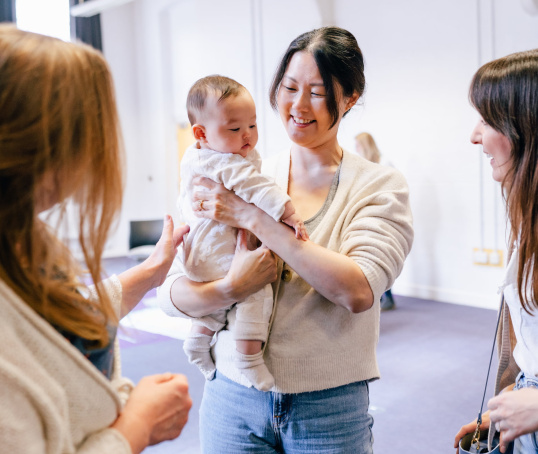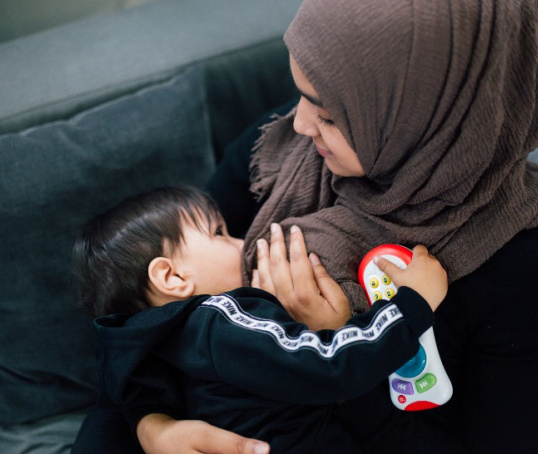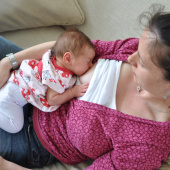You’ve just given birth for the first time and now for another new thing – breastfeeding. So how exactly do you do it? Here’s our guide to getting started.
Starting skin-to-skin contact
A newborn's instincts to breastfeed are particularly strong after birth (NHS, 2016). So holding your newborn skin-to-skin can help them start to breastfeed (UNICEF, 2013; NICE, 2015; Moore et al, 2016). Skin-to-skin means holding your baby against your bare chest with them naked or dressed only in a nappy, usually under a light blanket.
You should be offered skin-to-skin contact with your baby as soon as possible after birth, whether you decide to breastfeed or not (NICE, 2015).
Skin-to-skin contact has positive effects on:
- starting breastfeeding –babies are more likely to breastfeed successfully at their first feed
- maintaining breastfeeding – mums are more likely to be breastfeeding successfully one to four months later
- helping stabilise your baby’s cardio-respiratory system (helping them to breathe), body temperature and blood glucose levels
- attachment between mum and baby
- reducing crying in babies.
(UNICEF, 2013; Moore et al, 2016)
How do I know when my baby is ready to feed?
You and your baby might both want to watch and wait a while, cuddling skin-to-skin, in a laid-back or semi-reclined position. After some time, your newborn might make hand movements and then start ‘rooting’ —turning towards your nipple and opening their mouth (NHS, 2016). This is a really good sign that they’re ready to feed.
"Skin-to-skin contact isn’t just for immediately after your baby is born. Your baby will love it if you do it any time during the first few weeks."
This will help with bonding while you become familiar with each other. It’s also a really good way to help your baby to attach successfully at your breast. They’re born to do this using their natural crawling and latching on reflexes (NHS, 2016; Colson, 2008).
If your baby is born by caesarean birth, you should still be able to have skin-to-skin contact straight after the birth (NHS, 2016). Your midwife can offer you extra help with positioning and attachment to protect your wound (NICE, 2015).
How long after birth will my baby breastfeed?
Many babies are ready to feed in the first hour but not all are.
If you’ve had pethidine (especially within four hours of the birth) or an epidural during labour, your baby may be more sleepy and unsure of what to do (NICE, 2015; French et al, 2016; Cadwell and Brimdyr, 2017). In these cases, you should be offered extra support with positioning and attachment (NICE, 2015).
What happens if I can’t breastfeed right after birth?
If skin-to-skin contact is delayed — for example if your baby needs time in special care — it doesn’t mean you won’t be able to bond with or breastfeed your baby (NHS, 2016). You should be offered skin-to-skin contact as soon as possible.
In the meantime, the midwife will show you how to express your milk until your baby is ready to breastfeed (NHS, 2016).
To wash or not to wash?
You probably wouldn’t have connected an early baby bath to breastfeeding. But interestingly, plenty of evidence suggests that waiting at least 12 hours after the birth before bathing a baby can also help kick-start breastfeeding (DiCioccio et al, 2019). So don’t be in too much of a hurry to wash your baby after birth. Does it really matter if they’re not squeaky clean anyway?
Find out more about how to breastfeed in your baby’s first few days here.
This page was last reviewed in March 2019.
Further information
NCT supports all parents, however they feed their baby. If you have questions, concerns or need support, you can speak to a breastfeeding counsellor by calling our helpline on 0300 330 0700, whether you are exclusively breastfeeding or using formula milk. Breastfeeding counsellors have had extensive training, will listen without judging or criticising and will offer relevant information and suggestions. You can also find more useful articles here.
You might find attending one of our NCT New Baby courses helpful as they give you the opportunity to explore different approaches to important parenting issues with a qualified group leader and other new parents in your area.
Make friends with other parents-to-be and new parents in your local area for support and friendship by seeing what NCT activities are happening nearby.
Cadwell K, Brimdyr K. (2017) Intrapartum administration of synthetic oxytocin and downstream effects on breastfeeding: elucidating physiologic pathways. Annals of Nursing Research and Practice. 2(3):1024. Available at: http://austinpublishinggroup.com/nursing-research-practice/download.php?file=fulltext/anrp-v2-id1024.pdf [Accessed 2nd January 2018]
DiCioccio HC, Ady C, Bena JF, Albert NM. (2019) Initiative to improve exclusive breastfeeding by delaying the newborn bath. J Obstetr Gynecol Neonatal Nurs. 48(2):189-196. Available at: https://www.jognn.org/article/S0884-2175(18)30391-5/fulltext [Accessed 2nd January 2018]
French C, Cong X, Chung K. (2016) Labor epidural analgesia and breastfeeding: a systematic review. Journal of Human Lactation. 32(3):507-20. Available at: https://www.ncbi.nlm.nih.gov/pubmed/27121239 [Accessed 2nd January 2018]
Moore ER, Bergman N, Anderson G, Medley N. (2016) Early skin-to-skin contact for mothers and their healthy newborn infants. Cochrane Database of Systematic Reviews. (11):CD003519. Available at: https://www.ncbi.nlm.nih.gov/pmc/articles/PMC6464366/ [Accessed 2nd January 2018]
NICE. (2015) Postnatal care up to 8 weeks after birth: clinical guideline [CG37]. Available at:https://www.nice.org.uk/guidance/cg37/chapter/1-recommendations#infant-feeding [Accessed 2nd January 2018]
NHS. (2016) Breastfeeding the first few days. Available at: http://www.nhs.uk/Conditions/pregnancy-and-baby/pages/breastfeeding-first-days.aspx?tabname=Your%20newborn [Accessed 2nd January 2018]
UNICEF. (2013) The evidence and rationale for the UK Baby Friendly Initiative Standards. Available at: https://www.unicef.org.uk/wpcontent/uploads/sites/2/2013/09/baby_friendly_evidence_rationale.pdf [Accessed 2nd January 2018]






